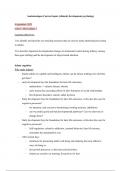Aantekeningen Current topics (clinical) development psychology
4 september 2023
week 1: Hoorcollege 1
Learning objectives:
1) to identify and describe eye-tracking measures that are used to study attentional processing
in infants
2) to describe important developmental changes in attentional control during infancy, among
them gaze shifting and the development of object-based attention
Infant cognition
Why study infants?
- human adults are capable and intelligent, infants can do almost nothing, how did they
get there?
- early development lays the foundation for later life outcomes:
- malnutrition -> chronic disease, obesity
- early trauma has cascading effects in later formation of social relationships
- Development disorders: autism, adhd, dyslexia
- Early development lays the foundation for later life outcomes, is this also the case for
cognitive processes?
- for attention, and executive functioning (working memory, inhibition)
- can we predict good and bad developmental pathways? Can we intervene to
change these?
- Early development lays the foundation for later life outcomes, is this also the case for
cognitive processes?
- Self-regulation: related to addiction, criminal behavior, later life income,
remember the marshmallow test.
- 1001 critical days
- manifesto for promoting infant well being and studying the most effective
ways of doing so.
- fast growth processes, in the brain and elsewhere.
- infants are sensitive to learning, for good or for bad
, - Early intervention and prevention are more effective than later interventions.
- scientific interest &
- How do infants learn so much? So fast?
- lots of learning going on!
- eating, drinking, sleeping, concepts, language, counting, looking around.
- Sleeping
- There is much learning going and hence many important questions to answer?
- what are the stages in sensori-motor learning
- Which abilities in infancy are related to IQ and executive functioning (EF),
what drives development?
- Can we find precursors to later developmental problems? Can we find
precursors to later developmental problems? Can we base interventions on
those?
- how do infants grow up to be healthy and thriving adults?
How to study infants?
Standardized tests\
- Bayley’s scale of infant development
- motor development, grasping, manipulating objects
- attention
- pointing, naming of objects
- IBQ: infant behavior questionnaire
- measuring temperament
Standardized tests limitations
- cumbersome, time- consuming
- requires much training
- parents measures are not measuring the infant
- sometimes not very reliable
From year one: Visual preference method
- infants show systemic preferences for faces, complex and new stimuli.
- visual preference method:
, - assumption: longer looking time:
- preference/interest
- being able to distinguish stimuli
- looking times can be used to study the development of perceptual and
cognitive abilities
- what can infants perceive at what age?
- what do infants know at what age?
From year 1: Habituation-dishabituation
- same-different learing
- approximate number system
- what will infants pay attention to?
- Naive physics
- repeated presentation of the same stimulus
- looking time (=attention) decrease = habituation
- looking time increase again upon presentation of a novel stimulus =
- Novel stimulus = an opportunity to learn!
looking behavior
- is available to infants very early on, visual acuity develops almost completely before 3
months
- looking behavior in VPC and habituation measures are unreliable (remember setup by
Fantz)
- saccades/looking behavior is under control (more so than eg. arms/legs)
- looking is seen as a measure of attention: what is the infant thinking of?
How to measure attention?
- EOG; electric measures of eye movements
- not very accurate; problem with artifacts
- only movement, not position.
- eye tracking (discussed after this)
- physiological measures
- heart-rate
- EEG, ERP, FMRi, fNIRS
- indirect: marker tasks
, eye tracking technique
- use a light to illuminate the eye (infrared, invisible)
- Use of a camera to film the eye
- use an algorithm to detect the corneal reflection, the iris and determine the eye gaze
position.
- raw eye-tracking data: every 1,2,5 ms gaze position
- Data needs to be processed into fixations and saccades
- fixations: relatively stable position
- saccade: fast movement to a new location
- measures: fixation, duration, fixation location, fixation shifts (=saccades)
history
- Yarbus studies gaze patterns
- what do gaze patterns look like depending on the instructions they are given?
Applications
- web browsing behavior
- additional data eg in questionnaire research, next to answers & response times, used
eg to detect exam fraud
- strategy detention in development psychology
How to study infants? summary
- standardized tests are often subjective (parental reports), cumbersome to administer
and/or unreliable
- studying infants directly: looking behavior provides a windows into the infant mind,
VPC, habituation, basic processes related to complex cognitive processes and their
development
- Early methods: manual scoring and determination of gaze position are interesting but
still unreliable.
- Eye-tracking offers much more data (high frequency measurements) & more
precise/reliable data.
Part 3
What to study Infants
(Infant) eye movements)




